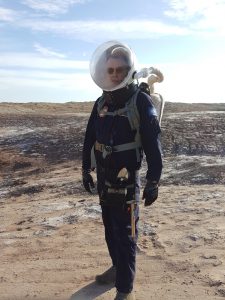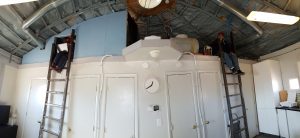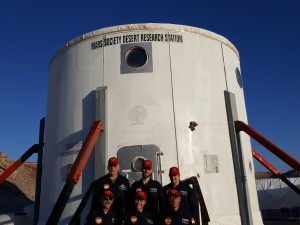By Heather Michon
Correspondent
 A Fluvanna man just returned from Mars.
A Fluvanna man just returned from Mars.
Or at least a close approximation.
Michael Lawson of Troy spent two weeks at the Mars Desert Research Station (MDRS), a facility in the high desert of Southern Utah which simulates the type of habitat humans might one day build on the Martian plains. MDRS is one of three such simulations built and maintained by the Mars Society, a Colorado-based nonprofit founded in 1998 to advocate for the settlement and exploration of the Red Planet.
It’s a goal that Lawson supports.
“I was not quite ten when we landed [on the Moon],” he says. “And if you told me that, 50 years later, we would never have again left low-Earth orbit, I would have been highly, highly surprised.”
Lawson, a retired Army officer who now runs his own home inspection business, has had a passion for astronomy since childhood and took his first college-level astronomy course at the age of 15. More recently, he was a Community Scholar at the University of Virginia in the graduate astronomy program. He’s also had a long-time fascination with Mars. “I’ve read extensively and I’ve devoured fiction and nonfiction,” he says. A rotation at the MDRS seemed like it might provide some good challenges.
The first challenge was getting into the program. “Most of the crews are reserved for organizations or institutions,” he explains, and there is heavy competition for the few spots open each year to individuals. “I was very fortunate to be accepted.”
He arrived in Utah in late November as part of Crew 216. MDRS is located just outside Hanksville, an isolated town of around 100 people, three hours or more from the nearest hospital or airport.
Crew 216 was a diverse lot, including a Russian documentary filmmaker, a teacher from Singapore, a dentist, a PhD in comparative literature, and a graduate student in aerospace engineering. Their crew commander had spent a year at Antarctica South Polar Station, and his experience with that kind of isolation assured that “he knew where the pressure points were and was able to massage that through.”
 Despite differing backgrounds, ages, and nationalities, Lawson says the group bonded almost instantly. “We hit the lottery on this,” he adds. Some crews never gel; in fact, the previous crew had gotten along so poorly, they wouldn’t even sit for a group photo at the end of their rotation.
Despite differing backgrounds, ages, and nationalities, Lawson says the group bonded almost instantly. “We hit the lottery on this,” he adds. Some crews never gel; in fact, the previous crew had gotten along so poorly, they wouldn’t even sit for a group photo at the end of their rotation.
The campus is spartan: a few small structures connected by closed walkways, set in a valley surrounded by low hills. To replicate the conditions colonists will face on Mars — where temperatures might go up to 70 degrees on a summer day and plummet to minus 100 at night — crew members must put on simulated spacesuits whenever they leave the buildings.
The living quarters, called the Hab, are small. Crew members are assigned small rooms “wide enough for your bunk and a little workspace,” he says. To simulate the water scarcity on Mars, each crew member was rationed to about five gallons per day drinking, food preparation, hygiene, and sanitation. “We all brought copious amounts of baby wipes” to stay fresh, he adds.
 Food was mostly freeze-dried, and the crew had to figure out how to turn, say, a can of desiccated chicken into a palatable meal. Planning those nightly meals as a team turned out to be “an important thing for bonding.”
Food was mostly freeze-dried, and the crew had to figure out how to turn, say, a can of desiccated chicken into a palatable meal. Planning those nightly meals as a team turned out to be “an important thing for bonding.”
Their days were filled with tasks. “There’s no such thing as deferred maintenance in space,” Lawson explains. “So a lot of your time is devoted to housekeeping tasks, because if something goes wrong — you die.”
Excursions outside took planning and preparation. Their spacesuits, which included full helmet and breathing apparatus, weigh between 30-40 pounds. Trudging the hillsides around in heavy gear at high altitude burned the calories. Lawson says he lost 16 pounds in 14 days.
Each member also had some sort of project to complete during the mission. Mining for new minerals and metals is likely to be an important part of Mars exploration, so Lawson tested out a faster way to survey the terrain for mineral deposits using ultraviolet light. He plans to write a scientific paper on his findings over the holidays.
Lawson is clear-eyed about the limitations of the simulation. “There’s artificialities involved, but they’re doing the best they can with the money they’ve got.” In reality, the first crew to colonize Mars will be carefully chosen and rigorously trained for the nine-month, 153-million-mile journey; they will bring with them living facilities designed for long-term habitation on an often hostile planet.
When will that happen? Hard to say, but it will likely be several more years before a project comes together, at a cost of billions of dollars.
Lawson says his trip to MDRS was mostly for “self-actualization,” but now that he’s home, he’s hoping to “spark young minds” about the potentials in space and the importance of studying science, technology, and engineering. He’s already reaching out to local groups who might want to hear about his experiences.
In all, Lawson found his journey to be a positive, interesting couple of weeks — but he did come home to one major complaint. His children informed him that “parents aren’t supposed to be cooler than their kids.”




